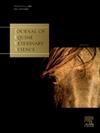An investigation into the prevalence of groin and pelvis area pain in male equestrian riders
IF 1.6
3区 农林科学
Q2 VETERINARY SCIENCES
引用次数: 0
Abstract
Horse riding is recognized as one of the most hazardous sports, surpassing skiing, motor racing, and rugby in injury risk. While acute injuries such as fractures, contusions, and concussions often result from falls, chronic issues like back pain are also prevalent. Despite substantial research focusing on female riders, limited attention has been given to pain and injury in male equestrian athletes. This study investigates the prevalence of pain in the groin, pelvis, and buttock areas among male horse riders and evaluates the impact of saddle design and other factors on these discomforts. A predominantly quantitative approach was employed, utilizing a survey of 384 over 18 years old, male riders who completed a questionnaire comprising 20 open and closed questions. Fifty-seven percent of participants reported to have experienced pain or injury in the groin, penis, or pelvic area during riding. The findings reveal a prevalence of testicular pain (36.3%) and nerve-related pain/issues (20.5%), with fewer reports of prostate pain/issues (5.3%). Notably, 43% of riders reported needing to temporarily stop riding due to pain. Saddle design emerged as a critical factor influencing pain risk; riders using deep-seat saddles were 1.6 times more likely to experience pain than those using flat-seat saddles across disciplines (OR: 1.56 95% CI: 1.12–2.17). For dressage, deep-seat saddles were associated with significantly higher pain prevalence, while for jumping, deep-seat saddles presented a 38.9% pain probability compared with 31.6% for flat-seat saddles (OR: 1.38, 95% CI: 0.98–1.91). The study further revealed that rider skill level had no significant correlation with pain frequency (P = 0.555). Factors exacerbating pain included underwear choice (43.7%) and the sitting trot (32.5%). These findings highlight the need for improved riding-specific underwear, development of ergonomic saddle designs, and targeted interventions to address male-specific health concerns in equestrian sports. Future research should prioritize male rider health and comfort to mitigate pain and improve performance.
调查流行的腹股沟和骨盆区域疼痛的男性骑手
骑马被认为是最危险的运动之一,在受伤风险方面超过了滑雪、赛车和橄榄球。虽然骨折、挫伤和脑震荡等急性损伤通常是由跌倒引起的,但背痛等慢性问题也很普遍。尽管大量的研究集中在女性骑手身上,但对男性马术运动员的疼痛和损伤的关注却很有限。本研究调查了男性骑手腹股沟、骨盆和臀部疼痛的患病率,并评估了马鞍设计和其他因素对这些不适的影响。主要采用定量方法,对384名18岁以上的男性骑手进行了调查,他们完成了包括20个开放式和封闭式问题的问卷调查。57%的参与者报告说,在骑行过程中,腹股沟、阴茎或骨盆区域疼痛或受伤。研究结果显示睾丸疼痛(36.3%)和神经相关疼痛/问题(20.5%)的患病率,前列腺疼痛/问题的报告较少(5.3%)。值得注意的是,43%的骑手报告说,由于疼痛,他们需要暂时停止骑行。鞍座设计成为影响疼痛风险的关键因素;使用深座马鞍的骑手经历疼痛的可能性是使用平座马鞍的骑手的1.6倍(OR: 1.56 95% CI: 1.12-2.17)。对于盛装舞步,深座马鞍与更高的疼痛发生率相关,而对于跳跃,深座马鞍的疼痛发生率为38.9%,而平座马鞍的疼痛发生率为31.6% (OR: 1.38, 95% CI: 0.98-1.91)。进一步研究发现,骑手技术水平与疼痛频率无显著相关(P = 0.555)。加剧疼痛的因素包括内衣的选择(43.7%)和坐着小跑(32.5%)。这些发现强调了改进骑行专用内衣、开发符合人体工程学的马鞍设计以及有针对性的干预措施以解决马术运动中男性特有的健康问题的必要性。未来的研究应该优先考虑男性骑手的健康和舒适,以减轻疼痛和提高表现。
本文章由计算机程序翻译,如有差异,请以英文原文为准。
求助全文
约1分钟内获得全文
求助全文
来源期刊

Journal of Equine Veterinary Science
农林科学-兽医学
CiteScore
2.70
自引率
7.70%
发文量
249
审稿时长
77 days
期刊介绍:
Journal of Equine Veterinary Science (JEVS) is an international publication designed for the practicing equine veterinarian, equine researcher, and other equine health care specialist. Published monthly, each issue of JEVS includes original research, reviews, case reports, short communications, and clinical techniques from leaders in the equine veterinary field, covering such topics as laminitis, reproduction, infectious disease, parasitology, behavior, podology, internal medicine, surgery and nutrition.
 求助内容:
求助内容: 应助结果提醒方式:
应助结果提醒方式:


